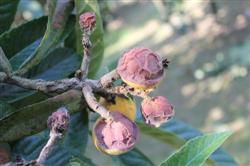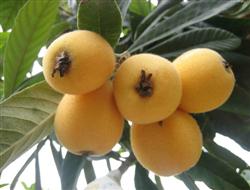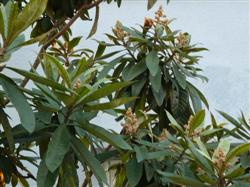Nutrition and fertilization techniques of Loquat

The main results are as follows: (1) the amount and times of fertilizer applied to cultivate loquat commonly used fertilizers, including manure, livestock and poultry manure, cake fertilizer, compost, garbage fertilizer, burning soil and chemical fertilizer. According to the mineral nutrition requirements of loquat growth and development, loquat belongs to the plant with high potassium demand, and the potassium content of loquat fruit is almost 3 times that of nitrogen. Too much nitrogen fertilizer, large fruit, but strong color and taste, poor appearance and quality; if too much potash fertilizer, the fruit contains more sugar, but the meat is rough. Therefore, all kinds of fertilizer elements should be matched properly. Young loquat trees should be fertilized 5-6 times a year, and the method of thin fertilizer should be applied frequently, about once every two months. Each plant is treated with 15-25 kg of rotten rare human (pig) manure and urine (20% of the concentration), or 150-250 g of imported compound fertilizer. For adult fruit trees of loquat, fertilizer is usually applied three times a year, mainly according to the characteristics of fertilizer demand and phenological period of loquat. The summary of fertilizer application varies slightly from place to place. The 15-20-year-old loquat garden in Putian Mountain, Fujian Province, applied 10-13 kg of nitrogen, 8-10 kg of phosphorus and 13-15 kg of potassium every 667 square meters per year. It can be roughly divided into the following times: ① postharvest fertilizer was applied from May to June. It is mainly to supplement the nutrients consumed by the results, restore the tree potential, promote the sturdiness of summer shoots, and promote root growth and flower bud differentiation. Give priority to quick-acting fertilizer, combined with deep ploughing, apply a large amount of mature organic fertilizer. The proportion of nitrogen, phosphorus and potassium fertilizer is generally 3:2:2. The amount of fertilizer applied accounts for about 40% and 50% of the total amount of fertilizer applied throughout the year. Late-maturing varieties can be applied in advance before fruit harvest. Taking Loquat-Shaped Cake with a yield of 35 kg as an example, each loquat tree should apply imported compound fertilizer 0.75-1.0kg and chicken manure 10-12kg. ② pre-anthesis fertilizer is from September to October, the flower bud differentiation is basically finished in autumn, and when the flower ear begins to appear, it is applied to provide the nutrition needed for flowering and fruit and vegetative autumn shoots, promote flowering well and improve the cold resistance of the plant. Mainly organic fertilizer. The ratio of nitrogen, phosphorus and potassium is generally 5:4:5. The amount of fertilizer applied accounts for about 30% and 40% of the annual fertilizer application. Each plant is 10-13 kg of chicken manure. ③ spring shoot strong fruit fertilizer was applied after fruit thinning from February to March. The function of this fertilization is to promote the growth of spring shoots and roots, provide nutrients for the growth of young fruits, promote the growth of young fruits, reduce fruit drop, and promote and enrich spring shoots. With the application of available fertilizer combined with compound fertilizer, the ratio of nitrogen, phosphorus and potassium fertilizer is generally 3:4:3. Such as more phosphate fertilizer in the soil, or less hanging fruit at that time, the proportion of phosphate fertilizer can be reduced. Those whose trees are not growing will increase the proportion of nitrogen fertilizer. The amount of fertilizer applied accounts for about 20% of the total fertilizer application in the whole year. 30-50 kg of rotten rare manure and urine, 0.3-0.6 kg of imported compound fertilizer and 0.25-0.5 kg of potash fertilizer were applied to each plant. February is the period of the largest root growth in the whole year, and the depth of fertilization should be shallow to avoid root damage. In Putian, Fujian, loquat farmers combine ploughing and ploughing after fruit harvest, applying 30-35 kg of chicken manure per plant. When loquat trees bear fruit for a long time, the fruit is rapidly expanded and ploughed and cultivated, with 30-35 kg of chicken manure per plant. When loquat trees bear fruit for a long time, they are sprayed with foliar fertilizer solution 2-3 times before the rapid expansion period of the fruit (0.2% UV 0.4% potassium dihydrogen phosphate, 0.2-0.4% urea and 0.2-0.3% potassium sulfate), once every 10 days. (2) the fertilization effect of loquat is closely related to the fertilization method. The absorbing root system of loquat tree is mainly concentrated in the soil layer around the crown projection, and the production takes the crown dripping line as the fertilization site. The fertilization of loquat root system can also be used to apply fertilizer to the place where the root system is concentrated, which can guide the root system to expand deeply or outward and expand the root range. In addition, the characteristics of fertilizers should also be considered, such as poor mobility of phosphate fertilizer and easy to be fixed by red soil. Therefore, phosphate fertilizer should be deeply applied, hole applied and applied in the rhizosphere to improve the absorption and utilization of phosphate fertilizer. When applying phosphorus with calcium or bone meal, it should be mixed with ring manure, barnyard manure or human feces and urine, and applied after maturity, the effect is better. The common soil fertilization methods in loquat orchard are: ① ring fertilization, also known as wheel fertilization. A little outside the canopy, dig a ring-shaped ditch, apply fertilizer, and then cover the soil. The basic fertilizer ditch should be deeper, 40-50 cm, and the topdressing ditch should be shallow, 15-30 cm. The fertilizer ditch should be moved out year by year. This fertilization method has the advantages of simple operation, economical use of fertilizer and so on. However, it is easy to cut off some fast-growing horizontal roots, and the range of fertilization is small, which should be paid attention to in selection. ② disc fertilization takes the trunk as the center and rakes the soil into a disk. The place that depends on the trunk is shallow, the farther away from the trunk, the deeper it is. There are also those who only make flat-bottomed fertilizer plates. The raked soil is piled around the outside of the plate, forming the edge of the ridge. After fertilizing, cover the soil. This method is suitable for topdressing because it is applied shallowly and the water is easy to hurt the root. However, long-term application of this method will cause the root system of loquat tree to move up. ③ radiation ditch fertilization with the trunk as the center, 60-80 cm away from the trunk, dig 6-8 incident trenches, 20-30 cm deep, fertilization in the trench. The position of the ditch was changed every other year or every other year to increase the absorption surface of loquat roots. This method has less root injury, and if combined with circular fertilization, the effect of fertilization is better. But when digging trenches, you should avoid the big root so as not to damage it. ④ strip ditch fertilization in the crown drip line on both sides of the trench, or in the loquat orchard between rows or plants to open a ditch, basal fertilizer ditch should be deeper, 50-60 cm; topdressing ditch should be shallow, 15-30 cm. Then apply fertilizer to the ditch, and then cover the soil. The next time you apply fertilizer, you can change the other sides and move outward year by year, combined with deep ploughing and ripening soil. This is a better method of fertilization. ⑤ whole garden fertilization for adult loquat orchard, loquat root system has been spread all over the garden, fertilizer can be evenly distributed throughout the garden, and then turned into the soil. If the whole garden fertilization is combined with strip fertilization or radiation ditch fertilization, the fertilizer effect can be better developed. In this method, the fertilization is shallow, and it is easy to make the loquat root move up. ⑥ extra-root topdressing is also called foliar spraying fertilizer. Extra-root topdressing is a method of dissolving fertilizer in water and spraying it directly on the leaves of loquat trees so that the leaves can absorb and utilize nutrient elements directly. The method of topdressing outside root is simple and easy, the amount of fertilizer is small, and the absorption and utilization is fast. Extra-root topdressing plays an important role in protecting flowers and fruits, promoting fruit development, improving quality, correcting element deficiency, improving fertilizer efficiency (preventing soil chemical or biological fixation) and regulating loquat tree potential. However, the effect of extra-root topdressing is short, which can only play an auxiliary role and can not completely replace soil fertilization. Leaves are the center of physiological and biochemical activities of loquat trees. The stomata and stratum corneum on the leaves have the ability to absorb fertilizer. The back of the young leaves during the growing period has a strong ability to absorb fertilizer. Usually, the leaf absorbs the same fertilizer as the root system. Under acidic conditions, anions are easily absorbed, while under alkaline conditions, cations are easily absorbed. Most of the trace elements used in extra-root topdressing are simple fertilizers. The suitable spraying concentration of various fertilizers is shown in Table 4-5. Extra-root topdressing in spring, the concentration can be slightly higher; in summer and autumn high temperature and drought season, the concentration should be appropriately lower, so as to avoid fertilizer damage. When many kinds of fertilizers are mixed, the suitable concentration should be reduced proportionally. In addition, it can also be combined with pest control spray for extra-root topdressing, but we must pay attention to the acidity and basicity of fertilizers and medicament types, acidity and alkalinity can not be mixed. ⑦ special fertilization in some hills and mountainous areas, serious soil erosion, nutrient leaching, easy to cause element deficiency. In addition, acidic soil is often lack of phosphorus and calcium, alkaline soil is often lack of iron, etc., the use of soil fertilization is not effective. For this reason, a better fertilization effect can be achieved by adopting some special fertilization methods. One is to cover roots and fertilize. In the period of root interplanting fertilization, it should be in the root growth and absorption period, and the better effect should be 5-7 days after flowering. The concentration applied is generally slightly lower than that used for extra-root topdressing. The method is as follows: using a 10 cm × 15 cm plastic bag and filling 100-200 ml fertilizer solution, about 30-50 cm in the east, south, west and north dripping lines of the loquat canopy, pull out a bunch of fibrous roots with more new roots; insert it into the plastic bag containing fertilizer and tie up the mouth of the bag to prevent water evaporation. This method is effective in the treatment of element deficiency. The second is infusion and fertilization. Transfusion fertilization is generally carried out one month before the sap flow in early spring, flower bud germination and fruit ripening. It can protect flowers and fruits and promote fruit development and flower bud differentiation. Fertilizer solution is 0.5 liter of water, 6 grams of urea, 4 grams of potassium dihydrogen phosphate, 4 grams of boric acid in early spring, trace amounts of alcohol, and 3 grams of ferrous sulfate when iron deficiency. The device is like a hanging bottle in a hospital. The production method is as follows: the fertilizer solution is filled with a glue bottle so that the cover does not leak. Insert two needles into the lid and connect the hose. A 40cm hose is used for air intake, and the other 60cm hose is connected to the needle leading into the tree. Use a nail to drill a hole 20 cm above the ground in the trunk of the loquat tree, reaching as deep as the xylem. Then, hang the bottle, insert the needle into the hole, see that the liquid is seeping out, and seal the hole with white wax. Third, drip irrigation and fertilization. Drip irrigation is also an advanced fertilization and irrigation technology. The utility model has the advantages of timely supply of fertilizer, uniform distribution of fertilizer, no root damage, protection of soil structure, less labor and less fertilizer consumption. However, at present, there are many problems in production, such as the water quality can not meet the requirements, and it is easy to cause emitter blockage and so on. It needs further technical improvement before it can be widely used in production.
- Prev

Fertilization is the key to early fruiting and high yield of loquat.
Fertilize the young trees. Young loquat trees should be fertilized 5-6 times a year. It is best to apply it once a month in the year when it has just been planted. Mix inorganic fertilizer with thinner human feces, urine or organic fertilizer, and apply 1: 1.5 kg of each plant to 25 cm around the tree. From the second year, apply shoot-promoting fertilizer before each shoot germination and spread the shoot every 15 to 20 days.
- Next

Skillful management of loquat trees in winter
One is to apply winter fertilizer, control crazy striping, strong flower genes and flower organ ovary. Promotion and control, flower promotion, disinfection and activity are completed at one time. So that the fruit trees blossom, sit more fruit, protect fruit, strong fruit, stable yield and high quality. The second is to do a good job in thinning and keeping flowers. The growth of young loquat trees should allow them to expand their crown, apical flowers and.
Related
- Moge, come on! The staff of the peasant association in the producing area of cantaloupe were frightened when the crowd gathered.
- Causes and Solutions of low Fruit setting rate of Apple
- Symptoms and control measures of passion fruit virus disease
- Fruit growing lesson: how do apple orchards keep high yields?
- Can you build orchards in the mountains? What are the pros and cons?
- How to manage the coloring period of Crisson grape?
- This paper introduces the processing technology of two kinds of fig products.
- How much is a month for retired teachers in rural areas by 2020?
- How can strawberry planting increase sugar content? We should pay attention to management in many aspects.
- What are the cultivation techniques on how to improve the yield of golden fruit?

